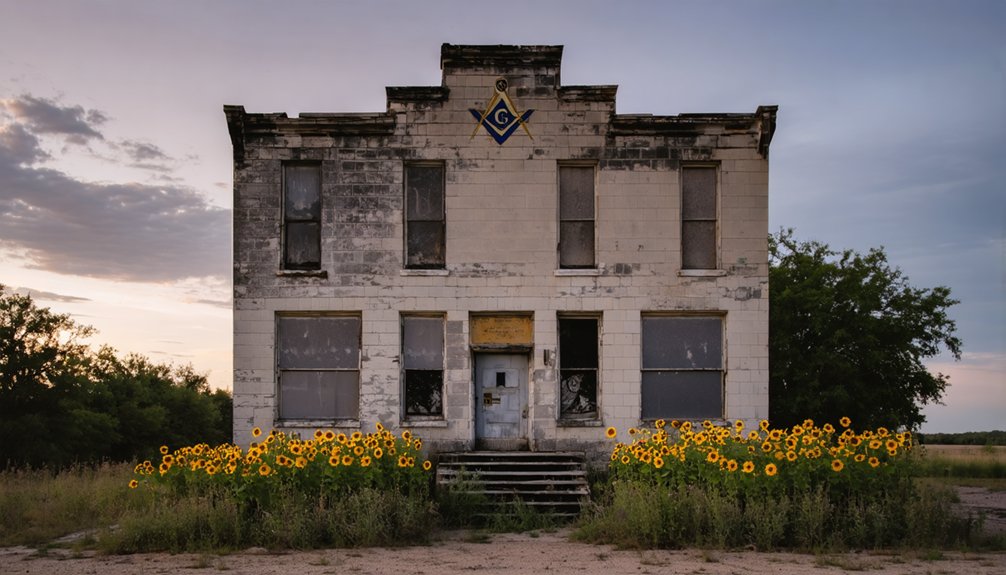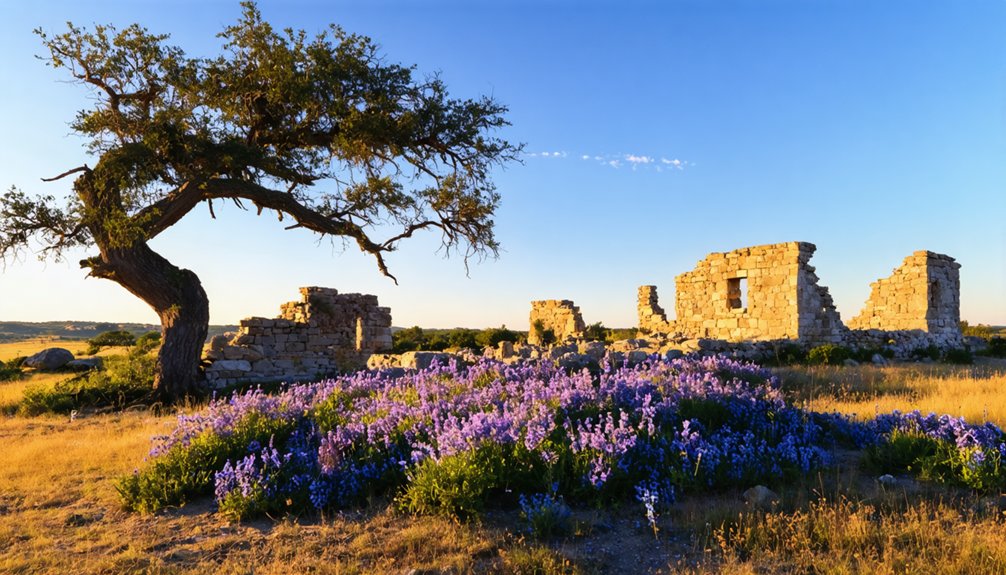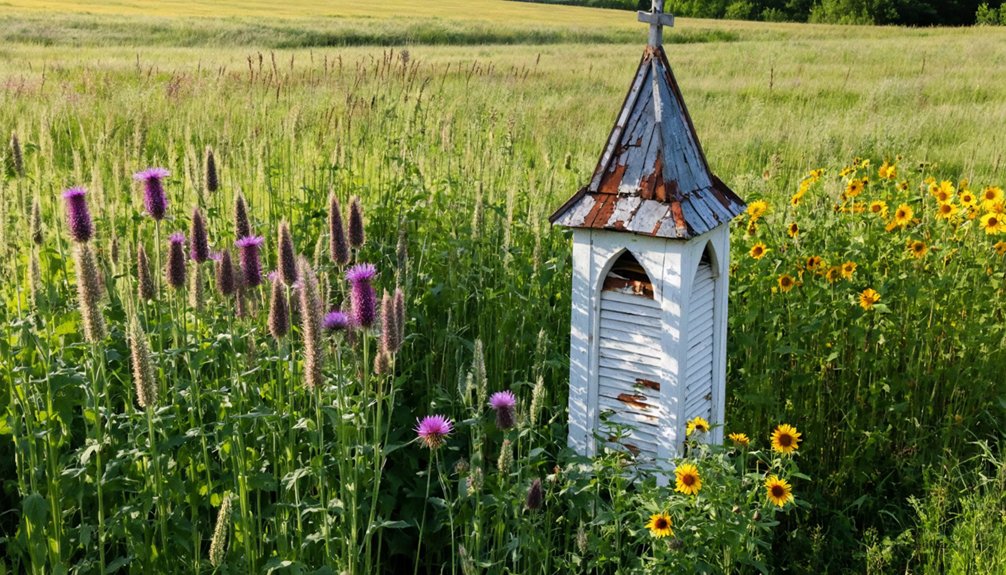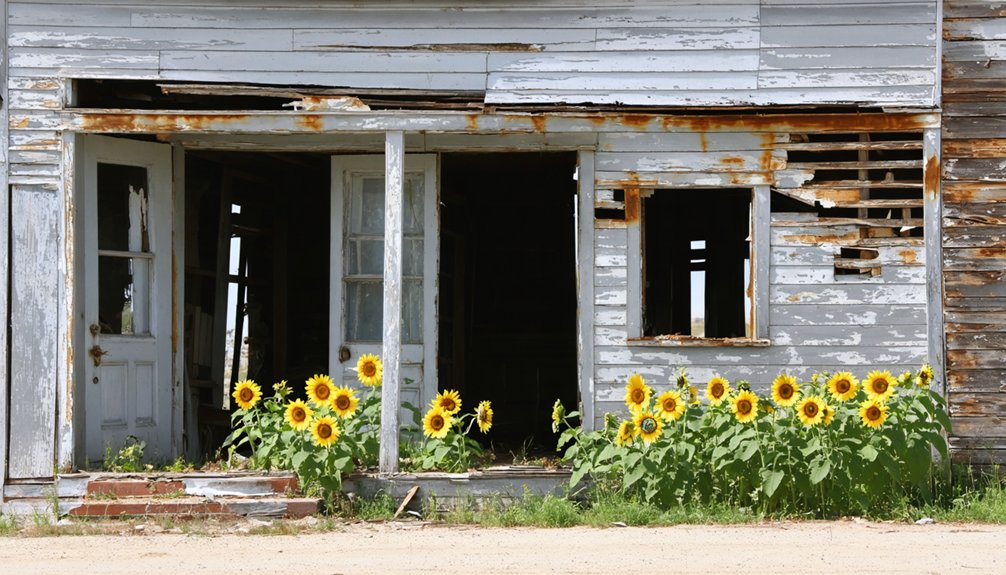You’ll find Flora, Texas, situated in Fort Bend County, where it emerged as a settlement after 1894. Named after schoolteacher J.C. Florea, the community thrived with early pioneers like the Conner families establishing homesteads and agricultural operations. The town boasted a post office from 1849 to 1966 and a prominent Masonic Lodge. Despite its promising start, Flora’s bypassing by railroads and economic challenges transformed it into today’s ghost town, where untold stories await in its remaining landmarks.
Key Takeaways
- Flora, Texas became a ghost town after being bypassed by railroad development and experiencing economic decline in the late 1890s.
- The town’s last major institution, its post office, closed in 1966, marking the final phase of Flora’s transformation into a ghost town.
- Originally established after 1894 in Fort Bend County, Flora thrived briefly through agriculture before facing economic instability and population loss.
- A Texas Historical Commission marker erected in 2001 preserves Flora’s history as a ghost town in the Piney Woods region.
- Natural disasters, failing agricultural operations, and the closure of local businesses contributed to Flora’s abandonment and ghost town status.
The Birth of a Wildflower Town
While the exact origins of Flora, Texas remain somewhat mysterious, historical records indicate the community emerged after 1894 in Fort Bend County during post-Civil War settlement expansions.
You’ll find its name likely stems from J.C. Florea, a schoolteacher from Missouri who made his mark on the nascent community. According to Wharton’s historical records, the settlement patterns of this region were carefully documented and preserved through community contributions.
The town’s location proved significant, as you’d discover extraordinary wildflower diversity in the surrounding landscapes. Native bluebonnets and Indian paintbrush created stunning displays across the region’s varied terrain, from oak woodlands to open grasslands. With less than 3% of Texas land being public, the area’s natural beauty was largely preserved through cooperative private landowners.
Vibrant bluebonnets and Indian paintbrush paint nature’s canvas across Flora’s diverse landscape, from wooded groves to sweeping prairies.
The ecological significance of Flora’s setting became evident through its position near the Eocene Queen City Formation, which supported distinct plant communities. This geological foundation, combined with favorable rainfall patterns, created ideal conditions for the rich tapestry of wildflowers that would become synonymous with the area.
Early Pioneer Settlement Years
You’ll find Flora’s earliest pioneer roots in the 1860s when A.F. and H.F. Conner established their homesteads in Hopkins County.
Among the region’s first settlers were Old Three Hundred members John C. Clark and Robert Kuykendall, who helped establish the early foundations of the area.
The Conner families played an essential role in laying the groundwork for what would become the Flora community, clearing land and establishing basic agricultural operations.
Their settlement efforts created a foundation for other pioneer families who’d soon follow, contributing to the area’s transformation from wilderness to an emerging agricultural settlement.
Like George Lord who struck it rich during the Gold Rush and purchased 8,000 acres in Texas, these early pioneers shaped the development of settlements across the state.
Settlement by James Beene
When James K. Beene established his homestead in Flora during 1845, he laid the foundation for what would become a significant pioneer settlement in Smith County. Like many who use historical records on genealogy sites today, Beene kept detailed documentation of the early settlement.
You’ll find that Beene’s leadership quickly emerged through his strategic choice of location, selecting fertile land that proved ideal for community agriculture and sustenance hunting.
The establishment of a post office in 1849 marked Flora’s growth as an early Texas settlement.
Early Community Development
Following Beene’s initial settlement, Flora experienced significant growth through the 1840s and 1850s as pioneer families established their presence in the area.
The A.F. and H.F. Conner families arrived in the early 1860s, followed by the Austins, marking key settler interactions that shaped the community’s foundation. These early pioneers developed essential trades, with a local tannery producing crucial leather goods for daily life. The community expanded with three practicing doctors by 1860.
The establishment of a post office strengthened Flora’s infrastructure, while agricultural development provided economic sustainability.
Your predecessors demonstrated remarkable community resilience as they navigated relationships with nearby Cherokee groups led by Chief Bowles. They built churches that served as cultural anchors and established cemeteries, creating the crucial social framework that would sustain Flora through its pioneering years.
Notable Businesses and Community Life
During Flora’s peak business period, you’d find a bustling post office that served as a crucial communication hub for the growing community until it closed in 1966.
Similar to towns like Old Bluffton, Flora saw its community life thrive in the early years before economic changes led to its decline.
The town’s Masonic lodge operated as an important social and civic organization before its eventual relocation, which signaled broader changes in the town’s fortunes.
You can trace the town’s commercial decline through the closure of various businesses by 1871, when many essential services began disappearing from the local landscape.
Tannery Operations and Trade
The bustling commercial heart of Flora centered on its tannery, which produced leather goods primarily for shoes and harnesses.
You’d find skilled workers employing traditional tannery techniques, processing animal hides through chemical treatments to create durable leather products that served the region’s agricultural needs.
The leather trade flourished alongside Flora’s other enterprises, with three general stores and two blacksmith shops complementing the tannery’s operations. Historical preservation efforts have helped document how community contributions sustained these local businesses through archival records.
You could watch craftsmen repair metal fittings for harnesses while trading goods at local stores.
The town’s commercial reach expanded when the post office opened in 1902, though this peak proved brief, ending by 1905.
The tannery’s success helped establish Flora as a crucial hub for farmers and travelers needing quality leather goods and essential services.
Masonic Lodge Activities
Among Flora’s most influential institutions, Quitman Masonic Lodge (later Flora Lodge No. 119) established deep roots in the community when it petitioned for its charter on January 5, 1852.
You’d find the lodge serving as a cornerstone of Flora’s social fabric, where Masonic rituals and community outreach initiatives brought citizens together for mutual support and civic improvement.
The lodge’s influence grew steadily, and by 1860, it stood prominently alongside the town’s doctors, blacksmiths, and merchants.
Members often held leadership positions in Flora, strengthening the lodge’s role in local governance and commerce.
In 1949, they constructed a new two-story building, demonstrating their lasting commitment to the community.
Through their Community Builders Award and charitable activities, Flora Lodge No. 119 remained an essential force in shaping the town’s development.
Post Office Mail Services
Since Flora’s early development hinged on reliable communication, James K. Beene established the community’s first post office in 1849. This significant service created one of the area’s earliest postal routes, connecting settlers to wider communication networks beyond their isolated homesteads.
You’d find the post office serving as more than just a mail hub. It became a bustling gathering spot where you could catch up on local news, maintain social connections, and conduct business transactions.
The postmaster played an important role in managing both official correspondence and personal letters that sustained family ties across distances.
The post office’s strategic location influenced Flora’s growth, attracting businesses and shaping the development of local trade routes. It remained essential to the community’s commercial activities until later consolidations affected many small-town postal services.
The Role of the Masonic Lodge

Masonic influence in Flora began taking shape when Lodge 158 established its presence near Duck Creek in 1855, operating until 1882 in what would later overlap with present-day Lindale.
You’ll find that Quitman Masonic Lodge, later known as Flora Lodge No. 119, became a cornerstone of community identity before the Civil War, eventually constructing a notable two-story building in 1949.
The lodge’s membership included prominent citizens like John S. Ogburn, F.M. Boyd, and T.J. Morris, who shaped local governance and social reform.
You’d have seen these leaders organizing charitable activities and social events that strengthened Flora’s civic fabric.
As part of Texas’s growing Masonic network, which expanded to 250 lodges with over 10,000 members by 1866, Flora’s lodge fostered vital social connections in this rural community until its eventual decline.
Economic Decline and Population Loss
While the Masonic Lodge provided social cohesion for Flora’s residents, the town’s economic foundation began crumbling in the late 1890s. The main economic drivers – the Waterhouse Rice and Sugar Company, along with supporting agricultural facilities – faced mounting instability through multiple ownership changes and market fluctuations.
You’ll find three crucial factors that accelerated Flora’s decline:
- Loss of agricultural prominence as the sugar mill and irrigation operations faltered
- Devastating impacts from recurring natural disasters, including hurricanes and tornadoes in 1909, 1910, 1918, and 1929
- Transportation impacts from being bypassed by railroad development, while nearby towns gained essential rail connections
Without reliable transport links and stable industry, Flora’s population steadily dwindled as residents sought opportunities elsewhere, leading to closed businesses and diminished community services.
Natural Beauty and Geographic Setting

Despite its economic decline, Flora’s natural setting in Smith County showcases the stunning beauty of East Texas’ Piney Woods region.
You’ll find yourself surrounded by dense hardwood forests of oak, hickory, and pecan trees, interwoven with gentle rolling hills and peaceful creeks.
The area’s humid subtropical climate supports a thriving ecosystem where natural wildlife abounds.
White-tailed deer, raccoons, and numerous bird species make their home among the pine-studded landscape.
Throughout spring and early summer, wildflowers paint the countryside in vibrant colors, creating picture-perfect scenes along scenic trails.
Each spring brings a kaleidoscope of wildflowers, transforming Flora’s winding trails into nature’s own living art gallery.
The mix of open pastures and forested areas provides year-round greenery, while small streams cut through the terrain, attracting diverse aquatic life and migratory birds.
This rich ecological tapestry continues to thrive, preserving Flora’s natural heritage.
Historical Landmarks and Records
Before its complete abandonment in 1871, Flora supported several businesses and a Masonic lodge that served as the town’s social hub.
The town’s historical significance is now primarily preserved through a Texas Historical Commission marker erected in 2001, standing as a symbol of this once-thriving community.
When you visit Flora today, you’ll find:
- Few physical structures remaining from the original settlement period
- The historical marker as the main point of reference for ghost town preservation
- The former site where the Masonic lodge stood before relocating to Garden Valley
Unlike other Texas ghost towns that maintained courthouses or jails, Flora’s rapid decline left little architectural heritage.
The town’s history is mainly documented through state records and historical databases, making the marker your primary source for understanding Flora’s past.
Legacy in Hopkins County

As Flora’s influence waned in Hopkins County during the late 19th century, its legacy became intertwined with the broader pattern of rural Texas settlement decline.
You’ll find traces of community resilience in how Flora’s residents adapted, with the Masonic lodge strategically relocating to Garden Valley by 1871. The town’s agricultural heritage lives on through historical documentation, preserved in county archives and state markers.
Flora’s story parallels that of Who’d Thought It, another Hopkins County settlement that succumbed to similar forces decades later.
While both communities now stand silent, their impact endures through educational records, social connections, and settlement patterns that shaped northeastern Texas.
Today, these ghost towns serve as powerful reminders of Hopkins County’s evolving rural landscape and the freedom early settlers sought.
Frequently Asked Questions
Were There Any Major Conflicts or Battles Fought Near Flora?
Like a TikTok without views, Flora didn’t see major battles. You won’t find Civil War combat or significant land disputes there, though the region experienced scattered frontier skirmishes with Native Americans.
What Happened to the Families Who Originally Lived in Flora?
You’ll find the original families moved away due to economic decline in the late 19th century, following typical family migration patterns as they sought better opportunities in larger Texas towns and cities.
Did Flora Have Any Connections to Native American Settlements?
With 16,000 years of Native American history in Texas, you’ll find Flora’s land was part of Tonkawa and Lipan Apache territories, though specific Native settlements and cultural exchanges weren’t documented within Flora’s boundaries.
Were There Any Famous Outlaws or Lawmen Associated With Flora?
You won’t find any outlaw legends or lawman tales connected to Flora – historical records, databases, and local archives show no evidence of famous frontier justice figures in this settlement.
Did Flora Experience Any Significant Natural Disasters During Its Existence?
As you scan the historical records like a detective searching for clues, you won’t find evidence of flood impacts or drought effects. No significant natural disasters struck Flora during its existence.
References
- https://www.hmdb.org/m.asp?m=91839
- https://www.tshaonline.org/handbook/entries/glen-flora-tx
- https://www.youtube.com/watch?v=WpekoOVhLN0
- https://www.tshaonline.org/handbook/entries/flora-tx-hopkins-county
- https://en.wikipedia.org/wiki/List_of_ghost_towns_in_Texas
- https://www.texasescapes.com/TexasGulfCoastTowns/GlenFloraTexas/GlenFloraTexas.htm
- https://epay.tarleton.edu/C20203_ustores/web/product_detail.jsp?PRODUCTID=64
- https://www.tshaonline.org/handbook/entries/flora-tx-fort-bend-county
- https://texashighways.com/outdoors/the-rogue-wildflower-hunters-of-texas/
- https://fwbg.org/wp-content/uploads/2025/04/SBM_26_pp1_272.pdf



